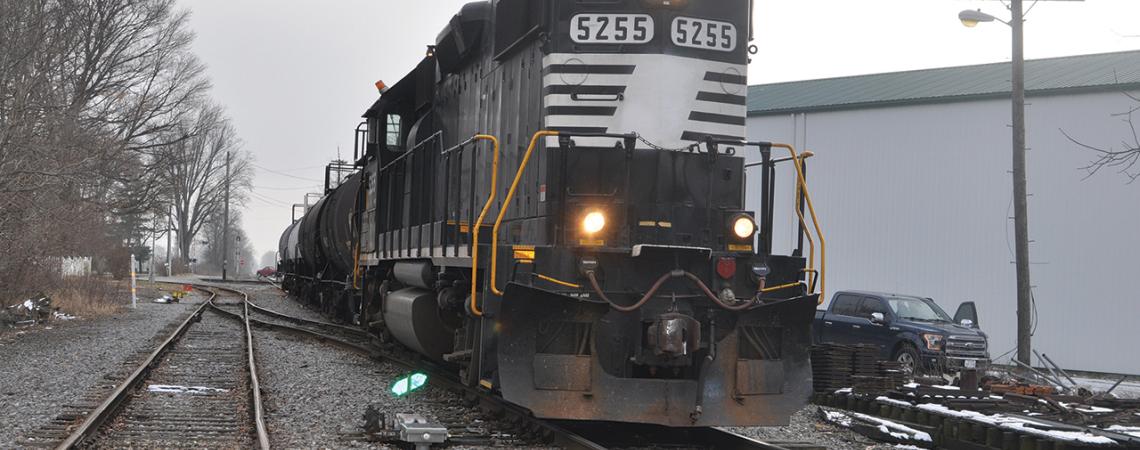Engine 5255, a 100-ton locomotive christened in 1979, is Indiana Eastern Railroad’s “work-horse” that pulls cargo to and from New Haven, Ohio.
Layhigh Road is a little-traveled ribbon of asphalt in rural western Butler County. Occasionally, however, a traveler might encounter a sleek, black locomotive emerging from the woods and thundering down the track that crosses Layhigh behind an X-shaped crossbuck. As quickly as the locomotive appears, it fades away, a phantom train in broad daylight.
“Some people who live along this line say they have never seen a train here,” says Jason Bynum, the engineer who drives the Indiana Eastern Railroad (IERR) train on its twice-weekly runs. Most people living along the tracks are away at work when it passes.
Grain, solvents, acids, cardboard, and coal are just some of the cargo hauled by what are more formally called Class III (short line) rails. The short lines are the scrappy, nimble rails that do what the big ones (Class I) — think CSX or Norfolk Southern — don’t or can’t.
Indiana Eastern has a sister line, Ohio South Central Railroad, that honeycombs through the hardscrabble hills of Appalachia in Jackson County, where the rails serve businesses as diverse as Austin Powder, an almost two-century-old maker of explosives, and Totino’s Pizza Rolls, which are made in Jackson. The headquarters of Ohio South Central is in the Vinton County town of Hamden.
The nerve center of the IERR is a converted former farmhouse just across the state line from Butler County. On an overcast December morning, Bynum, officially IERR’s operations manager, and conductor Tony Pickens go over paperwork and plan their day, which will include a 26-mile trip to two chemical plants in New Haven, Ohio.
Before the locomotive and five chemical cars can set off, though, there is work to be done. They can’t grab just any chemical car. You can’t, for example, put sulfuric acid in a tanker that once held liquid nitrogen. So, they have to make sure to pull the correct car out of storage on a siding track, “which is like shuffling a deck of cards,” Bynum says.
In this case, the “cards” are 250,000-pound chunks of steel. On this morning, the tank car they want is 11 deep in a line, so Pickens has to pull 10 cars off the siding onto the main track. Bynum backs them far enough to get them out of the way, throws the train into reverse and hooks to the needed car, pulls it onto the track, and then hooks back to the 11 unneeded cars and deposits them back onto the siding. The entire process of plucking cars out of storage with all the associated maneuvering takes almost 90 minutes.
Once the lineup is set, the 261,000-pound locomotive begins chugging southwestward at a peak speed of 25 mph through farm fields harvested bare for the winter. The train thunders through the town of Bath, Indiana, and then crosses the border into Ohio. Farm fields gradually give way to a bucolic countryside of hamlets and hills. The track crosses Buck Creek over a dramatic trestle bridge and then ambles alongside Paddy’s Run Creek near Shandon, an area that once attracted Welsh settlers who were drawn to the area by its resemblance to their home country.
“It’s all personal. It’s not just a job,” Pickens says. Pickens spent nine years working for CSX, one of the largest railroads in the country. He’s now spent 13 years at the “wheel” at IERR because he likes the variety that a short line offers. The entire operation is run by Pickens, Bynum, and Scott Vance, IERR’s track inspector, who can also step seamlessly into the role of conductor or engineer, if needed. They replace railroad ties, fix retaining walls, cut back brush from the tracks, install and maintain crossing equipment, and help drum up business for their line. They keep a chainsaw on board the train in case they happen upon a fallen tree on the tracks.
“The reason we are successful is that we have maintained a low administrative overhead,” says George Andres, who owns both railroads. “We have good, dedicated people who are cross-trained. That gives us flexibility in how we operate, it keeps costs down, and it lets us maintain a personal relationship with all of our customers.”
The short lines serve as a vital economic lifeline for rural Ohio. “The train is pretty much the lifeblood of our process,” says Jeff Baker, production manager at Nutrien, one of the plants Bynum’s train services in New Haven. Nutrien has food-grade phosphate brought in by train, Baker says, because getting the needed volume by truck wouldn’t be cost-effective.
The Ohio Rail Association (ORA), an advocacy group for the state’s short lines, takes any opportunity to highlight the economic-vitality aspect.
“Short lines are critical in so many ways,” says Art Arnold, president of the ORA. “They are local employers and economic-development lifelines, whether they are bringing in materials or hauling out product.”









